Abstract
An alternative approach, known today as the Bernstein polynomials, to the Weierstrass uniform approximation theorem was provided by Bernstein. These basis polynomials have attained increasing momentum, especially in operator theory, integral equations and computer-aided geometric design. Motivated by the improvements of Bernstein polynomials in computational disciplines, we propose a new generalization of Bernstein–Kantorovich operators involving shape parameters , and a positive integer as an original extension of Bernstein–Kantorovich operators. The statistical approximation properties and the statistical rate of convergence are also obtained by means of a regular summability matrix. Using the Lipschitz-type maximal function, the modulus of continuity and modulus of smoothness, certain local approximation results are presented. Some approximation results in a weighted space are also studied. Finally, illustrative graphics that demonstrate the approximation behavior and consistency of the proposed operators are provided by a computer program.
Keywords:
weighted ℬ-statistical convergence; shape parameter α; shape parameter λ; blending-type operators; computer graphics MSC:
41A10; 41A25; 41A36; 26A16; 40C05
1. Introduction
The Weierstrass approximation theorem asserts that there exists a sequence of polynomials that converges uniformly to for any continuous function on the closed interval [1]. Bernstein provided an alternative proof of the well-known Weierstrass approximation theorem, nowadays called Bernstein polynomials. The following Bernstein operators
where,
were given in [2] to approximate a given continuous function on
In this sense, an approximation process for Lebesgue integrable real-valued functions defined on was presented by replacing sample values with the mean values of r in the interval (see [3]). It is well known that these operators involving Lebesgue integrable functions on can be expressed by means of the Bernstein basis function ,
There are several generalizations and different modifications of the Kantorovich operators in the literature (see e.g., [4,5,6,7,8]).
Approximation methods by Bernstein-type operators have been used both in pure and applied mathematics, as well as in certain computer-aided geometric design and engineering problems. For instance, a numerical scheme for the computational solution of certain classes of Volterra integral equations of the third kind and an algorithm for the approximate solution of singularly perturbed Volterra integral equations were provided with the help of Bernstein-type operators [9,10].
A new class of Bernstein operators for the continuous function on , which includes the shape parameter α and named hereafter as α-Bernstein operators, were constructed in [11]. Many modifications of α-Bernstein operators have been studied (see [4,5,12]). A new basis with shape parameter λ was introduced in [13], and a new type λ-Bernstein operators were constructed by shape parameter λ in [14]. Shape parameters α and λ were used to modify Bernstein operators to α-Bernstein-type (see [4,11,12,15,16]) and λ-Bernstein-type operators (see [6,13,17,18,19,20,21,22,23,24,25]) in order to have better approximation results.
Quite recently, Cai et al. estimated rates convergence of univariate and bivariate blending-type operators, which were introduced in [26], by a weighted A-statistical summability method [27].
The motivation of the paper is to extend Bernstein-type operators and introduce a novel generalization of blending-type Bernstein–Kantorovich operators that include many known sequences of linear operators in the literature.
The outline of the paper is as follows: In Section 2, we provide the needed background that includes definitions of α-Bernstein and λ-Bernstein-type operators. In Section 3, we introduce a novel generalization of Bernstein–Kantorovich operators with the help of a new class of basis polynomials involving two shape parameters and a positive integer. We also obtain moments and central moments and provide a classical Korovkin-type theorem. In Section 4, we focus on the convergence properties and a Voronovskaja-type approximation result of the operators through the notion of weighted -statistical convergence. Further, we estimate the rate of the weighted -statistical convergence of the proposed operators. In Section 5, we obtain some pointwise and weighted approximation results. In Section 6, we provide certain computer graphics for different kinds of functions to see the approximation of the defined operators. In Section 7, we provide a conclusion to summarize the obtained results.
2. Preliminaries
In this part, we provide the needed background that includes definitions of α-Bernstein, λ-Bernstein and blending (α, λ, s)-Bernstein basis functions; also, the definitions of α-Bernstein, λ-Bernstein and blending (α, λ, s)-Bernstein operators are provided.
Throughout the paper, let the binomial coefficients be given by the formula
The known α-Bernstein operators (see [11]) were introduced as
where , , and -Bernstein basis is given as
for , .
The -Bernstein operators were given as (see [14])
where -Bernstein basis is given as
Generalized blending-type -Bernstein operators with a positive integer s were introduced in [15] as
and
which depend on shape parameter where , .
Finally, blending-type -Bernstein operators were constructed in [26] as follows:
where , and s is a positive integer and the blending-type basis is given as
and is defined in Equation (1).
Lemma 1
([26], Theorem 2). If , for any and we have
3. Blending (α, λ, s)-Bernstein–Kantorovich Operators
Let denote the space of all Lebesgue integrable functions on the interval . We introduce the following sequence of operators involving shape parameters and , and a positive integer
and call it blending -Bernstein–Kantorovich operators.
Lemma 2.
Let s be a positive integer, and α be a non-negative integer, then the moments of blending -Bernstein–Kantorovich operators are as follows:
Proof.
Since it is easy to prove the first part of the theorem we skip it. Bearing in mind the definition of operators (2) and Lemma 1, we have
which completes the proof of second part. Now, we prove the third part:
□
Corollary 1.
The following relationships are satisfied:
Theorem 1.
Let , then we have
uniformly on
Proof.
Using the commonly stated Bohman–Korovkin theorem [28,29], our aim is to prove the following uniform convergence condition:
where , . Clearly, from the first and second parts of Lemma 2, we obtain
By the third part of Lemma 2, the following relationship is satisfied
□
4. Convergence Properties
In this part, we focus on the convergence properties and a Voronovskaja-type approximation result of operators through the notion of weighted -statistical convergence. Further, we estimate the rate of the weighted -statistical convergence of the proposed operators. We refer to [30,31] and the references therein for further information about statistical convergence and its weighted forms, including the regular summability matrix.
Let and . Then is called the natural density of K, if the limit exists. A sequence is called statistically convergent to a number L if, for each , The notion of weighted statistical convergence is given as:
Let be a sequence of non-negative numbers with and as , then is weighted statistically convergent to a number L if, for every ,
In [32], a new matrix method, which is known as -summability, was defined. Let be a sequence of infinite matrices with . Then is said to be -summable to the value -, if uniformly for
The method is regular if and only if the following conditions hold true (see [33,34]):
;
for each ;
.
By we denote the set of each regular method with for each p, k and i. Given a regular non-negative summability matrix , is said to be -statistically convergent to the number ℓ if, for every ,
uniformly in i, .
Definition 1
([35]). Let . Further, let be a sequence of nonnegative numbers with and as . A sequence is said to be weighted -statistically convergent to the number ℓ if, for every ,
In this case, we denote it by writing .
Theorem 2.
Let and . Then
Proof.
Let and be fixed. In view of the Korovkin theorem, it is sufficient to show that
where , and . By Lemma 2 and Corollary 1 we deduce that
Using the definition of proposed operators and Corollary 1, for one has
Now, for a given , choosing a number such that . Then setting
Thus we find that
Letting in the last inequality we obtain
Definition 2
([30]). Let . A sequence is statistically weighted -summable to L if, for each ,
In this case, we denote it by .
Theorem 3
([30]). Let be a bounded sequence. If u is weighted -statistically convergent to L then it is statistically weighted -summable to the same limit L, but not conversely.
Corollary 2.
Let and . Then
Proof.
The proof is a direct consequence of Theorems 2 and 3. Hence the details are omitted. □
Next, we estimate the rate of weighted -statistical convergence of to with the help of modulus of continuity of first order.
Definition 3
([30]). Let . Suppose that is a positive non-decreasing sequence. A sequence is said to be weighted -statistically convergent to ℓ with the rate if, for any ,
In this case, we denote it by
Theorem 4.
where ω is the usual modulus of continuity and
Let and be two positive non-decreasing sequences and let . Assume that the following conditions hold true:
- (i)
- ,
- (ii)
- on , where with Then
Proof.
Let and be fixed. Since is linear and monotone, we may write that
Taking the supremum over on both sides of (7), we observe that
where . Now, if we take in the last relation, we obtain
where . For a given , we define the sets:
Then the inclusion holds and
By hypotheses (i) and (ii), we have
This completes the proof of Theorem 4. □
Let be the space of all functions such that .
Theorem 5.
Let . Let and let u be a point of at which exists. Then
If , the convergence is also uniform in .
Proof.
Let and be fixed. By taking into account Taylor’s expansion with Peano’s form of reminder we conclude that
where is the remainder term such that and as Applying to identity (8), we get
Hence, in view of Lemma 2 and boundedness of the expression , we have
which completes the proof. □
5. Some Approximation Theorems Including Pointwise and Weighted Approximation
In this part, we provide some pointwise and weighted approximation results for operators Moreover, we establish two local approximation theorems for by the second-order modulus of smoothness and the usual modulus of continuity.
Lipschitz class is defined as follows: Let and denote the space of all continuous functions r on . Then, a function r in belongs to if the condition
holds, where the constant depends on r and .
Theorem 6.
Let , and then, for each ,
where is the distance between u and T, defined by
Proof.
Let so that where is a closure of T, then one has
By the help of relation
we have
We obtain the following relationships applying Hölder inequality to the above inequality for and :
We complete the proof by Lemma 2. □
Let and then Lipschitz-type maximal function of order [36] is expressed as
We provide a local direct estimate for by the next theorem.
Theorem 7.
Let and then, we have
for all .
Proof.
We have the following relations
by the help of (10). Further, applying Hölder inequality to the last inequality for
we observe that
The last inequality, together with Lemma 2 and the relation in (10) concludes the proof. □
Let be a weight function then, the weighted space denotes the set of all functions r on having the property
where a constant depending on r. It is known that is a Banach space equipped with the norm
Moreover, denotes the subspace of all continuous functions in and
Theorem 8.
Let then, for all , we have
Proof.
In view of the weighted Korovkin theorem, Definition 1 and Corollary 1, it is easy to see that
holds for . This completes the proof. □
Theorem 9.
Let and then, one has
Proof.
We have the following relationshops for any fixed :
Using the fact we have
Let be given. We can choose to be so large that the following inequality holds:
By the help of Corollary 1, we obtain
Further, for the choice of as large enough, we have
Moreover, bearing in mind the Korovkin theorem, the first term on the right-hand side of inequality (12) becomes
In order to give a local approximation theorem, we need to remember certain notions regarding the modulus of continuity, modulus of smoothness and Peetre’s K-functional.
The modulus of continuity of is defined by
where . The following inequality is satisfied for any and each :
The second-order modulus of smoothness of is defined as follows:
and the related K-functional is defined by
where and . It is also known that the inequality
holds for all , in which the absolute constant is independent of and r (see [37]).
Now, we establish a direct local approximation theorem for operators .
Theorem 10.
The following inequality is satisfied for the operators :
where C is an absolute positive constant, and
such that both terms and converge to zero when .
Proof.
We construct the operators , which preserves constants and linear functions for :
Let , then Taylor’s expansion formula for is
Applying to both sides of (18), we get
So
We get the following relationships taking (17) into account:
Theorem 11.
Let . For any , the following inequality holds:
Proof.
We have the following relationship
for any . Applying to the sides of the above relationship, we obtain
It is well known that for any and each ,
By the above inequality we have
Hence, we have
We get the following inequality if we apply the Cauchy–Schwarz inequality on the right hand side of (20):
We prove the theorem if we choose as □
6. Convergence by Graphics
In this section, we provide some graphics that demonstrate the consistency, accuracy and convergence of the proposed blending operators for different kinds of functions.
Example 1.
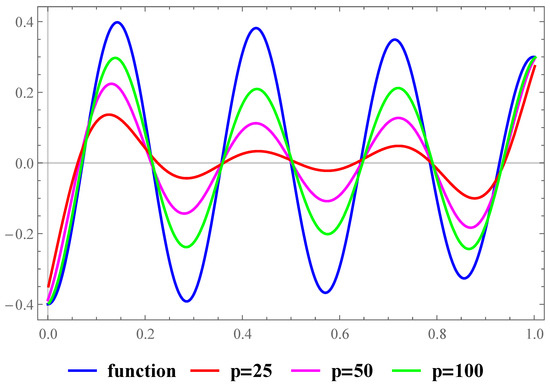
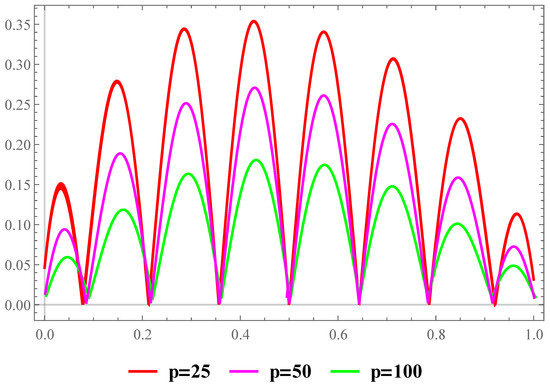
Consider the trigonometric function
on the closed interval In Figure 1 and Figure 2, we demonstrate approximation and maximum error of approximation of the proposed operators with the values , and

Figure 1.
Approximations by for function .

Figure 2.
Maximum error of approximation for function .
Example 2.
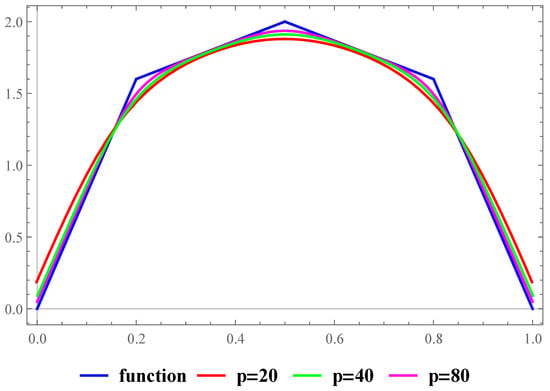
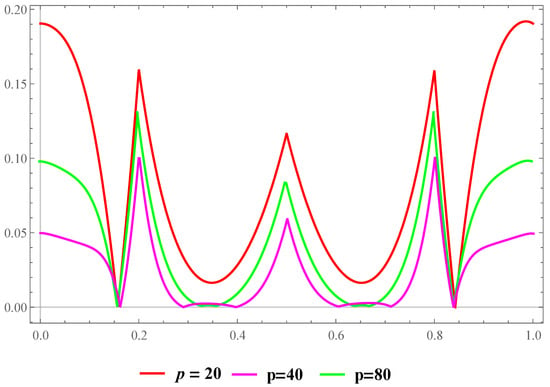
Consider the piece-wise function
on the interval (see [38]). In Figure 3 and Figure 4, we fix the values , and and change the values of p to see the approximation behavior and maximum error of approximation of the proposed operators.

Figure 3.
Approximations by for function .

Figure 4.
Maximum error of approximation for function .
Example 3.
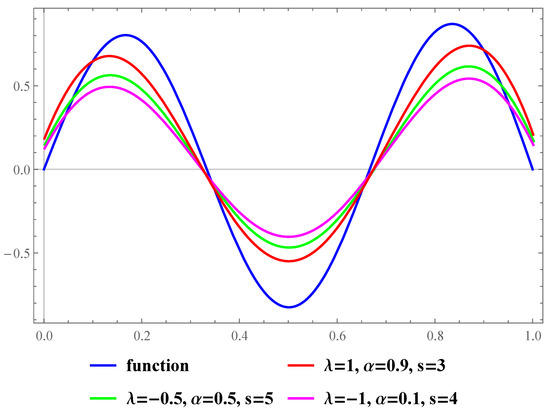
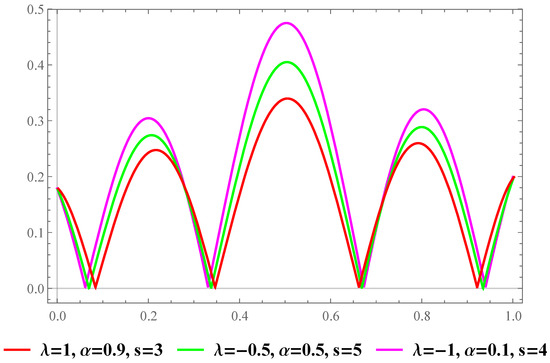
Consider the trigonometric function
on the closed interval In Figure 5 and Figure 6, we demonstrate approximation and maximum error of approximation of the proposed operators with certain different values of , α and and the fixed value of

Figure 5.
Approximations by for function .

Figure 6.
Maximum error of approximation for function .
Therefore, we demonstrate the consistency and accuracy of convergence behavior for the proposed blending-type operators via certain computer graphics. The graphics show that the proposed operators approximate different kinds of functions for different values of parameters , and
7. Conclusions
Many convergence results, including weighted -statistical, pointwise and weighted convergences, are obtained for the following introduced blending -Bernstein–Kantorovich operators:
The proposed operators extend the current literature for certain values of , and the positive integer
- (i)
- If we take , and , becomes the classical Kantorovich operators defined in [3].
- (ii)
- If we take and , becomes the Kantorovich operators defined in [6,39].
- (iii)
- If we take and , becomes the Kantorovich operators defined in [4].
As a continuation of this study, we will focus on a bivariate version of the proposed operators defined in this paper.
Author Contributions
Methodology, M.T.E. and E.A.; Visualization, F.Ö.; Supervision, F.Ö. and E.A.; Validation, E.A.; Writing (original draft), F.Ö.; Writing (review and editing), F.Ö., E.A. and M.T.E. All authors have read and agreed to the published version of the manuscript.
Funding
This research is in the process of getting support from the Ministry of Education and Science of Kosovo.
Institutional Review Board Statement
Not applicable.
Informed Consent Statement
Not applicable.
Data Availability Statement
Not applicable.
Acknowledgments
The authors extend their appreciation to the Ministry of Education and Science of Kosovo for funding this work.
Conflicts of Interest
The authors declare no conflict of interest.
References
- Weierstrass, V.K. Über die Analytische Darstellbarkeit Sogennanter Willkürlicher Functionen Einer Reellen Veränderlichen; Koniglich Preussischen Akademie der Wissenschcaften zu Berlin: Berlin, Germany, 1885; pp. 633–639, 789–805. [Google Scholar]
- Bernstein, S. Dámonstration du tháorème de weirstrass. Foundeá sur le calcul des probabilitás. Commun. Soc. Math. Kharkow 1912, 13, 1–2. [Google Scholar]
- Kantorovich, L.V. Sur certains developements suivant les polynomes de la forme de S. Bernstein I, II. Dokl. Akad. Nauk SSSR 1930, 568, 595–600. [Google Scholar]
- Mohiuddine, S.A.; Özger, F. Approximation of functions by Stancu variant of Bernstein-Kantorovich operators based on shape parameter α. RACSAM 2020, 114, 70. [Google Scholar] [CrossRef]
- Mohiuddine, S.A.; Ahmad, N.; Özger, F.; Alotaibi, A.; Hazarika, B. Approximation by the parametric generalization of Baskakov-Kantorovich operators linking with Stancu operators. Iran. J. Sci. Technol. Trans. Sci. 2021, 45, 593–605. [Google Scholar] [CrossRef]
- Özger, F. Weighted statistical approximation properties of univariate and bivariate λ-Kantorovich operators. Filomat 2019, 33, 11. [Google Scholar] [CrossRef]
- Kanat, K.; Sofyalıoğlu, M. On Stancu type generalization of (p, q)-Baskakov-Kantorovich operators. Commun. Fac. Sci. Univ. Ank. Ser. A1 Math. Stat. 2019, 68, 1995–2013. [Google Scholar] [CrossRef]
- Kadak, U.; Özger, F. A numerical comparative study of generalized Bernstein-Kantorovich operators. Math. Found. Comput. 2021, 4, 311. [Google Scholar] [CrossRef]
- Usta, F.; Akyiğit, M.; Say, F.; Ansari, K.J. Bernstein operator method for approximate solution of singularly perturbed Volterra integral equations. J. Math. Anal. Appl. 2022, 507, 125828. [Google Scholar] [CrossRef]
- Usta, F. Bernstein approximation technique for numerical solution of Volterra integral equations of the third kind. Comput. Appl. Math. 2021, 40, 161. [Google Scholar] [CrossRef]
- Chen, X.; Tan, J.; Liu, Z.; Xie, J. Approximation of functions by a new family of generalized Bernstein operators. J. Math. Anal. Appl. 2017, 450, 244–261. [Google Scholar] [CrossRef]
- Özger, F.; Srivastava, H.M.; Mohiuddine, S.A. Approximation of functions by a new class of generalized Bernstein–Schurer operators. RACSAM 2020, 114, 173. [Google Scholar] [CrossRef]
- Ye, Z.; Long, X.; Zeng, X.M. Adjustment algorithms for Bézier curve and surface. In Proceedings of the 2010 5th International Conference on Computer Science & Education, Hefei, China, 24–27 August 2010. [Google Scholar]
- Cai, Q.B.; Lian, B.-Y.; Zhou, G. Approximation properties of λ-Bernstein operators. J. Inequal. Appl. 2018, 2018, 61. [Google Scholar] [CrossRef] [PubMed]
- Aktuğlu, H.; Yashar, Z.S. Approximation of functions by generalized parametric blending-type Bernstein operators. Iran. J. Sci. Technol. Trans. Sci. 2020, 44, 1495–1504. [Google Scholar] [CrossRef]
- Mohiuddine, S.A.; Kajla, A.; Mursaleen, M.; Alghamdi, M.A. Blending type approximation by τ-Baskakov-Durrmeyer type hybrid operators. Adv. Differ. Equ. 2020, 2020, 467. [Google Scholar] [CrossRef]
- Özger, F. On new Bezier bases with Schurer polnomials and corresponding results in approximation theory. Commun. Fac. Sci. Univ. Ank. Ser. A1 Math. Stat. 2020, 69, 376–393. [Google Scholar]
- Srivastava, H.M.; Özger, F.; Mohiuddine, S.A. Construction of Stancu-type Bernstein operators based on Bézier bases with shape parameter λ. Symmetry 2019, 11, 316. [Google Scholar] [CrossRef]
- Aslan, R. Some approximation results on λ—Szász-Mirakjan-Kantorovich operators, Fundam. J. Math. Appl. 2021, 4, 150–158. [Google Scholar]
- Cai, Q.B.; Aslan, R. On a New construction of generalized q—Bernstein Polynomials Based on Shape Parameter λ. Symmetry 2021, 13, 1919. [Google Scholar] [CrossRef]
- Cai, Q.B.; Aslan, R. Note on a new construction of Kantorovich form q—Bernstein operators related to shape parameter λ. Comput. Model. Eng. Sci. 2022, 130, 1479–1493. [Google Scholar] [CrossRef]
- Ansari, K.J.; Özger, F.; Ödemiş Özger, Z. Numerical and theoretical approximation results for Schurer–Stancu operators with shape parameter λ. Comput. Appl. Math. 2022, 41, 1–18. [Google Scholar] [CrossRef]
- Srivastava, H.M.; Ansari, K.J.; Özger, F.; Ödemiş Özger, Z. A link between approximation theory and summability methods via four-dimensional infinite matrices. Mathematics 2021, 9, 1895. [Google Scholar] [CrossRef]
- Özger, F.; Ansari, K.J. Statistical convergence of bivariate generalized Bernstein operators via four-dimensional infinite matrices. Filomat 2022, 36, 507–525. [Google Scholar] [CrossRef]
- Özger, F.; Demirci, K.; Yıldız, S. Approximation by Kantorovich variant of λ-Schurer operators and related numerical results. In Topics in Contemporary Mathematical Analysis and Applications; CRC Press: Boca Raton, FL, USA, 2021; pp. 77–94. ISBN 9780367532666. [Google Scholar]
- Gezer, H.; Aktuğlu, H.; Baytunç, E.; Atamert, M.S. Generalized blending type Bernstein operators based on the shape parameter λ. J. Inequal. Appl. 2022, 2022, 1–21. [Google Scholar]
- Cai, Q.B.; Ansari, K.J.; Temizer Ersoy, M.; Özger, F. Statistical blending-type approximation by a class of operators that includes shape parameters λ and α. Mathematics 2022, 10, 1149. [Google Scholar] [CrossRef]
- Korovkin, P.P. Linear Operators and Approximation Theory; Hindustan Publishing Corporation: Delhi, India, 1960. [Google Scholar]
- Bohman, H. On approximation of continuous and of analytic functions. Ark. Math. 1952, 2, 43–56. [Google Scholar] [CrossRef]
- Kadak, U.; Braha, N.L.; Srivastava, H.M. Statistical weighted B-summability and its applications to approximation theorems. Appl. Math. Comput. 2017, 302, 80–96. [Google Scholar]
- Kadak, U. Statistical Summability of double sequences by the weighted mean and associated approximation results. In Applied Mathematical Analysis: Theory, Methods, and Applications; Springer: Cham, Switzerland, 2020; pp. 61–85. [Google Scholar]
- Kolk, E. Matrix summability of statistically convergent sequences. Analysis 1993, 13, 77–84. [Google Scholar] [CrossRef]
- Stieglitz, M. Eine verallgemeinerung des begriffs der fastkonvergenz. Math. Japon 1973, 18, 53–70. [Google Scholar]
- Bell, H.T. Order summability and almost convergence. Proc. Am. Math. Soc. 1973, 38, 548–552. [Google Scholar] [CrossRef]
- Mursaleen, M.; Nasiruzzaman, M.; Srivastava, H.M. Approximation by bicomplex beta operators in compact-disks. Math. Methods Appl. Sci. 2016, 39, 2916–2929. [Google Scholar] [CrossRef]
- Lenze, B. On Lipschitz-type maximal functions and their smoothness spaces. Indag. Math. 1988, 91, 53–63. [Google Scholar] [CrossRef]
- DeVore, R.A.; Lorentz, G.G. Constructive Approximation; Springer: Berlin, Germany, 1993. [Google Scholar]
- Khosravian-Arab, H.; Dehghan, M.; Eslahchi, M.R. A new approach to improve the order of approximation of the Bernstein operators: Theory and applications. Numer. Algorithms 2018, 77, 111–150. [Google Scholar] [CrossRef]
- Özger, F. Applications of generalized weighted statistical convergence to approximation theorems for functions of one and two variables. Numer. Funct. Anal. Optim. 2020, 41, 1990–2006. [Google Scholar] [CrossRef]
Publisher’s Note: MDPI stays neutral with regard to jurisdictional claims in published maps and institutional affiliations. |
© 2022 by the authors. Licensee MDPI, Basel, Switzerland. This article is an open access article distributed under the terms and conditions of the Creative Commons Attribution (CC BY) license (https://creativecommons.org/licenses/by/4.0/).